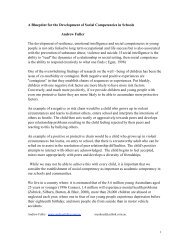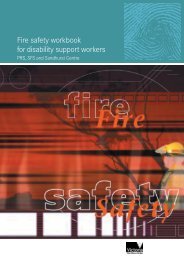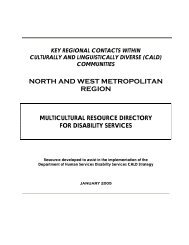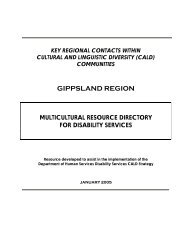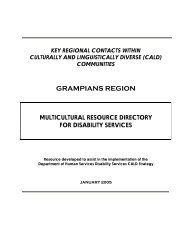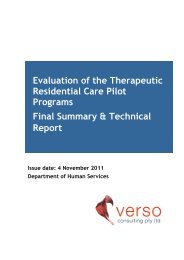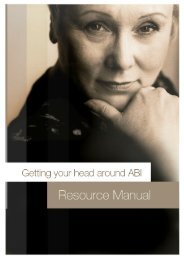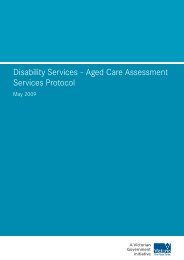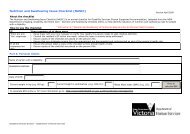Positive Behaviour Support - Department of Human Services - Vic ...
Positive Behaviour Support - Department of Human Services - Vic ...
Positive Behaviour Support - Department of Human Services - Vic ...
You also want an ePaper? Increase the reach of your titles
YUMPU automatically turns print PDFs into web optimized ePapers that Google loves.
86 <strong>Positive</strong> behaviour support: Getting it right from the start - Facilitators reference manual<br />
PowerPoint 117<br />
PowerPoint 118<br />
*<br />
*<br />
Using the <strong>Positive</strong> Intervention Framework identify strategies or ideas that you could<br />
implement to change or modify the behaviours <strong>of</strong> concern.<br />
General risk-minimising strategies<br />
Staff members who are prepared to respond to behaviour <strong>of</strong> concerns before they enter<br />
the working environment are less likely to injure or be injured during a serious episode <strong>of</strong><br />
the behaviour. The fully prepared staff member has a good understanding <strong>of</strong> the person, is<br />
appropriately dressed and has adequate mobility, well-practised observational skills and an<br />
organised plan for self-control.<br />
Knowledge <strong>of</strong> the person Rate your knowledge <strong>of</strong> the person<br />
1= little 2= some 3= lot<br />
Abilities and independent skills<br />
Preferences<br />
Know how to speak to person in a way that is meaningful<br />
Know the meaning <strong>of</strong> person’s unique ways <strong>of</strong> communicating<br />
Person’s warning signs<br />
Triggers<br />
How am I dressed?<br />
Earrings: Do earrings present a risk <strong>of</strong> tearing or cutting?<br />
Glasses: Are frames or lenses likely to break?<br />
Necklaces: Do necklace, ties, scarves etc provide an opportunity<br />
for choking?<br />
Accessories: Can ring, bracelets, watches or fingernails catch or tear skin?<br />
Clothing: Will my clothing keep me from jumping, running, bending<br />
and kneeling?<br />
Shoes: Do my shoes interfere with my ability to move quickly? Do my<br />
shoes present a risk <strong>of</strong> injury to others or myself?<br />
Keys: Does the way I carry my keys pose a risk <strong>of</strong> injury to myself or others?<br />
Emotional attachment: If my clothing or jewelry were damaged would<br />
I be upset?<br />
Look at the way you are dressed<br />
from head to toe and assess<br />
your attire in terms <strong>of</strong> risk it<br />
might present during a serious<br />
episode <strong>of</strong> the behaviour<br />
L low risk<br />
S some risk<br />
H high risk



